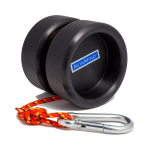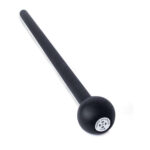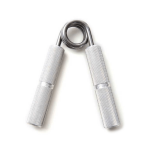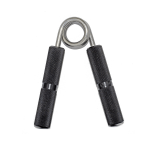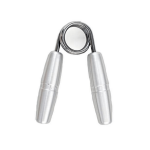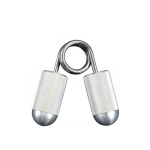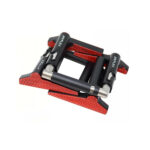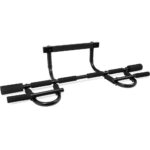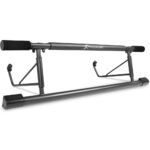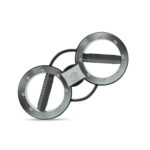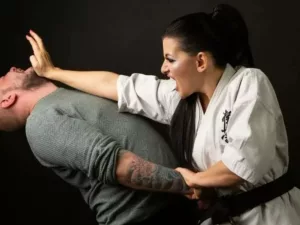(Last Updated on October 9, 2025 by Henry)
I’m going to take you through why beefing up your arm strength isn’t just about looking good; it’s a game-changer on the tennis courts. This isn’t just about your raw power; it’s also about precision, control, and steering clear of injuries that can toss you off your game.
You’re going to find out that having sturdy arms influences everything from your serve to your volley, and it doesn’t stop there. I’m here to help you understand the profound impact that increased arm and, specifically, hand grip strength can bring to your tennis performance.
- Gain oversight of arm strength in tennis performance
- The benefits of strong arms for power and injury prevention
- Learn about the importance of hand grip exercises
- The dynamics of arm circles, their impact on the player
- Incorporating resistance band stretches for flexibility
- Light cardio as a key to revving up for performance
Let’s be honest, you can always adjust your training plan down the road, but why not choose something that resonates with you right from the start? There’s a lot of opportunity to focus on specific muscle groups that contribute directly to your prowess on the court. In my opinion, that’s the strategy I like to leverage.
Now, before we swing into the warm-up exercises in the next section, let’s briefly touch upon what’s coming up. I’ve compiled a diverse collection of exercises tailored to tennis players, targeting everything from warm-ups to specific grip-strengthening moves. They all aim to pitch in toward your strength, control, and injury prevention goals.
Setting the Court: Vital Warm-Up Exercises for Tennis Players
I’m going to kick things off with a truth every tennis player should embrace: warm-up exercises are a game-changer. Think of your arm muscles as the strings of your racquet; perfectly tuned, they can significantly up your game. Let’s start with dynamic arm circles. I’m not just talking about flailing your arms around; it’s about controlled movements that enhance flexibility and blood flow, setting up your arms for those powerful shots.
Now, let’s introduce resistance band stretching into your routine. You’re going to find out about how these bands can improve your range of motion and reduce the risk of shoulder injuries, a common setback for tennis players. By pulling against the resistance, you’re not only warming up the muscles but also engaging them in a way that weights or bodyweight exercises can’t replicate.
Of course, warming up the whole body with some light cardiovascular activity is invaluable. Jump rope for coordination or jog lightly to get the heart pumping; both are prime examples. These practices are crucial for igniting your core temperature and prepping your muscles for the drills you’re diving into. And don’t worry too much about intensity here; it’s about getting moving and ready for action.
Serving Strength: Upper Arm Workouts to Power Your Swing
If you want to dominate the tennis court, your upper arms cannot be overlooked. It’s not just about how hard you can hit the ball; it’s also about the consistency and control you maintain through several sets. Here’s where targeted upper arm exercises come in. We’re going to delve into the specifics of bicep curls and triceps extensions, two foundational moves that will serve your game well.

Bicep curls are not just a staple gym exercise; for tennis players, they’re essential in achieving powerful strokes. When you execute a bicep curl with proper form, you’re not only strengthening the bicep but also training the muscles to work in coordination, which is crucial when swinging your racket.
Whether you’re using dumbbells, a barbell, or resistance bands, remember to keep your elbows close to your torso, lifting with control to avoid any jerky motions.
I can’t emphasize enough the importance of triceps extensions. If your biceps help you lift the racket, your triceps ensure you can bring it back down and control the racket’s follow-through.
Just like the biceps, triceps extensions can be performed in various ways, including overhead for a focused stretch and lying down for stability. No matter the variation, maintain proper alignment by keeping your elbows pointed forward and moving smoothly.
Now, let’s transition into some forearm exercises. After all, the forearms play a pivotal role in your grip and the subtle articulation needed for different shots. Up next, we’re going to tackle wrist curls and their counterparts, reverse wrist curls, before exploring the benefits that wrist rotations bring to your routine. Get ready to strengthen those forearms and enhance your gameplay significantly.
Forearm Fortitude: Grip Exercises for Precision and Control
Now, let’s turn our focus down to the forearms. These muscles are vital in tennis, allowing you to finesse your grip and ultimately control the racket during those critical moments of play. I’m going to walk you through a series of exercises specifically aimed at boosting your forearm strength.
Your go-to staple tool for grip can always be a simple spring gripper. They never go out of style, whatever your profession or application is. You can never go wrong with this one, and even better, all the other fancy tricks can be added to your basic gripper routine.
Let’s also get started with wrist curls. You’re going to need a barbell or a pair of dumbbells. Sitting down with your forearms on your thighs, palms up, slowly curl the weights towards your biceps, then lower them back down. This isn’t just about building muscle; it’s about enhancing your grip so you can manage your racket with precision during long rallies.
In contrast, reverse wrist curls target a different set of forearm muscles. This time, with palms facing down, you’ll be extending your wrists in an upward motion. These movements are crucial for those powerful backhand shots where wrist stability is key.
Finally, wrist rotations. You can do these with small weights or even a tennis racket. Extend your arm out in front of you, revolving the wrist in both directions. This exercise is going to prepare you for the twists and turns of the game, ensuring your grip is just as tight in the first set as it is in the last.
With your forearms primed and ready, it’s time to give some love to the shoulders – a critical region for those high-reaching services and smashes. But that’s a story for the next section, where I’ll be showing you how to develop shoulder strength that completes your arm conditioning for an all-around powerful game.
Shoulder the Game: Exercises for Powerful Overhead Shots
If you want to wield serious power in your overhead shots, you’ve got to focus on your shoulders. Serving, smashing, or reaching for that tough lob, your shoulders play a critical role in tennis. That’s where dumbbell shoulder presses come in. This classic exercise is all about increasing the strength of your deltoids, the major shoulder muscles, crucial for those high-impact shots.
To perform a dumbbell shoulder press correctly, choose a weight that feels challenging but doesn’t compromise your form. Sit or stand with your spine straight, and push the dumbbells from shoulder height straight above your head. The trick is to move steadily, without using momentum. You’ll be building the foundation for a powerful serve and improving your overhead game.
- Know the strategic importance of the dumbbell shoulder press
- Lateral and front raises are great for enhancing on-court mobility
- Customize shoulder workouts for honing specific tennis skills
- Court Core for Compound Moves for a Complete Tennis Workout
- Leverage push-ups to build foundational upper-body strength
- Pull-ups & chin-ups are the ultimate test of player endurance
- The comprehensive benefits of the bench press for tennis athletes

Now, don’t overlook lateral and front raises. These exercises may seem simple, but their impact on your tennis game can be huge. They specifically target the side and front deltoid muscles, enhancing shoulder stability and range of motion. When you’re waving goodbye to your opponent across the net after a match, you’ll thank those raises.
To maintain good form during lateral raises, stand with your feet hip-width apart, holding dumbbells at your sides. Then, raise your arms straight out to the side, parallel to the floor, and slowly lower them back.
For front raises, the movement is similar, but instead of going out to the side, you lift the weights straight in front of you. Feel free to mix it up with cables or wrist weights as variations to find what best stimulates your muscles.
Choose something that resonates with your training style and body needs. Every player is different, and your shoulder work should be no exception. Target those deltoids with care, and keep an eye on your shoulder health. It’s not just about building muscle; it’s also about ensuring those muscles can sustain long, intense matches.
Next up, we’re getting into the heart of your upper body’s power source with some compound exercises. You’ve worked on isolating specific muscle groups; now it’s time to integrate them with movements that’ll translate directly to your on-court prowess.
Court Core: Compound Moves for a Complete Tennis Workout
Picture this: You’ve just nailed a strong grip on your racket, strengthened by the targeted forearm exercises you’ve been practicing. Now, it’s time to build a more robust foundation with compound moves. These exercises aren’t just about your arms; they’re going to challenge multiple muscle groups, providing you with the overall upper body fortitude essential for every serve and volley.

Let’s kick things off with push-ups, a timeless classic that’s straightforward yet incredibly effective. The beauty here is in the simplicity; no fancy equipment needed, just your body weight and the right form.
Remember to keep your body straight, lower down with control, and push back up to fully engage your chest, shoulders, and triceps. Want a little twist? Consider incline or decline variations by using a bench to target the muscles differently.
Moving on to pull-ups and chin-ups, these are tough, I won’t sugarcoat it, but they’re worth the burn. You’re going to be hoisting your entire body weight, which is excellent for developing grip strength alongside back, bicep, and shoulder muscles.
Plus, these are vital for those explosive movements you need on the court. And if you’re thinking, ‘What if I can’t do one?’ That’s fine! There are assisted pull-up machines and resistance bands, or you can have a training partner help. The goal is to progress and improve over time.
Finally, let’s discuss the bench press. This powerhouse move directly correlates with the force behind your shots. When lying on the bench, drive up the weight with controlled precision, similar to the way you’d launch a power serve. Be it with barbells or dumbbells, you can switch it up to keep your muscles guessing and growing.
With these compound exercises, you’re not just building muscle; you’re creating a reservoir of strength that you can tap into during those critical match moments.
Don’t worry too much about hitting specific weights or numbers. Choose a resistance that challenges you and maintains proper form. It’s not a race; consistency is the key here.
Now, as you have your core stability dialed in, you might be wondering how to translate this raw strength into laser-focused tennis power. That’s where functional, tennis-specific training comes into play. In the next section, I’m going to show you how incorporating medicine ball throws, cable rotations, and resistance band shadow swings can not only boost your game but supercharge it.
Match-Ready: Functional, Tennis-Specific Training Techniques
I’m going to take you through some tennis-specific exercises that are game-changers. These are not generic gym routines; they’re tailored to mimic the movements and situations you’ll encounter on the court.
First up, medicine ball throws. These are fantastic for building the type of explosive strength you’ll unleash during a powerful serve or a forceful groundstroke. You’ll want to focus on form here, ensuring you’re mimicking the tennis serve motion to maximize the benefits.

- Medicine ball throws for that explosive service motion
- Cable rotations: mimicking the tennis swing for added power
- Enhancing stroke-specific strength with shadow swings
- Why cooling down matters: a guide to muscle recovery
- Arm, shoulder, and wrist stretches to maintain flexibility
- The role of foam rolling in post-game recuperation
Next, cable rotations are your go-to for rotational strength. Tennis is full of rotational movements, and these exercises help you fine-tune the muscles you use when you’re reaching for that wide forehand or whipping through a one-handed backhand.
Lastly, let’s talk about shadow swings with resistance bands. By mirroring your tennis strokes while facing the resistance of a band, you’re developing muscle memory and strength in the exact ways you’ll use them during play.
The beauty of these exercises is that they bolster your stroke-specific strength, the kind that transfers directly to your performance on the court. Incorporate them into your training, and you’ll feel the difference in every shot.
Now that you’re armed with functional exercises to enhance your game, it’s time to switch gears to recovery. Cooling down and stretching properly after these intense workouts is essential for muscle recovery and to maintain your flexibility. A cornerstone for injury prevention and longevity in tennis.
Recovery Tactics: Cool Down and Stretching Post-Match
After an intense session on the court, it’s tempting to call it a day and skip the cool-down. I’m going to remind you why that’s not the best idea. Just like prepping a meal before you can enjoy it, cooling down is crucial for your body’s recovery. It gradually lowers your heart rate and can prevent stiffness and soreness.
Muscle recovery is not just about feeling good; it helps prevent injuries as well. That’s going to include stretching exercises targeting your arms, shoulders, and wrists to maintain the range of motion you need for your next game. Remember, flexibility and tennis performance go hand in hand.
Foam rolling can be your best friend after those grueling matches. It’s like a massage for your muscles, breaking up knots and increasing blood flow for quicker recovery. Don’t worry too much about perfection here; just focus on the areas that feel tight and give them some attention. You can always adjust your approach down the road, but start with a simple rolling routine right after your match.
Your Game-Changing Routine: Integrating Hand Grip Exercises
I’m going to wrap things up by reminding you of the power that hand grip exercises hold over your tennis game. You’ve learned about upper arm workouts for boosting your forehand and backhand, specific forearm drills for that unbreakable grip, and shoulder exercises that prepare you for every overhead challenge.
This isn’t just about building muscle; it’s also about staying injury-free and bringing a new level of control and power to your game.
It’s clear that arm strength and grip are crucial components in tennis, and with the right exercises, you’re setting yourself up for success on the court.
I really hope that you incorporate these exercises into your training routine. Consistency here is key, as with all aspects of fitness and skill development.
Over time, you’re going to find out about the vast improvements in your game and how much more confident you feel with a racket in hand.

Don’t forget, your journey isn’t a solo one. I’d love to hear from you, how these exercises are shaping your play, any adjustments you’ve made, or the breakthroughs you’re experiencing. Share your story, drop a comment, and ask questions. By engaging, you’re not only helping yourself, but that shared knowledge helps the tennis community as a whole.
Thanks for sticking with me through this deep dive into tennis-specific hand grip strength exercises. Strike with precision, serve with power, and let’s make every game your best yet!
Thanks for Stopping By
Have Questions?
Please Leave A Comment


